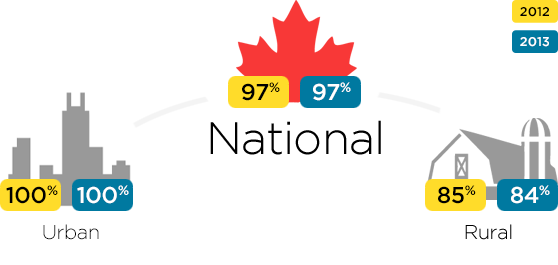“Any new medium, by its acceleration,
disrupts the lives and investments of whole
communities”
- Marshall Mcluhan, from Understanding media: The extensions of man, 1995
PAST FUTURES
Presented by: Jordan Abrey, America Blasco, Todd Jensen, Elena Matlo, Chie Seino, Robert Sparling
|
Source: Canadian Broadcast Corporation, 2015
|
What is the Digital Divide?The Organization for Economic Co-operation and Development (OECD) has defined the digital divide as an inequality in opportunities for accessing and using information and communication technologies between individuals, households, businesses, geographic areas and countries (OECD, 2001, p. 5).
Throughout Canada, many communities lack access to basic online services and the ability to access information and share knowledge. This results in many Canadians not being able to effectively participate in the digital economy (CRTC, 2016, p. 4). The Canadian Radio-television and Telecommunications Commission (CRTC) recently ruled that, in Canada, "broadband Internet with download speeds of at least 50 megabits per second and upload speeds of at least 10 Mbps will now be considered a 'basic telecom service.'” In addition, “all customers, even in rural areas where plans often have low caps on data usage, should have access to unlimited data options." (Dobby, 2016, para 2). |
CANADIAN BROADBAND AVAILABILITY AT A GLANCE:
In the chapter, “Roads and Paper Routes” from the text, Understanding media: The extensions of man, McLuhan defines the new digital age as “the global village,” in which space and time are dramatically reduced by electric technology (1995, p. 93). This reduction of space and time has not come without consequences. In the late 1990s, the gap between the “digitally rich,” and the “digitally poor” - or the “digital divide” - began to grow (Gasher, Skinner & Lorimer, 2016, p. 328), resulting in unequal distribution of access to information and communication technologies between individuals, households, businesses, geographic areas and countries (OECD, 2001, p. 5).
In 2015, The Canadian Internet Registration Authority revealed that 87% of Canadians have access to the internet (CIRA, 2015, para 1). This means that nearly one in eight Canadians are still without access to basic telecommunication services, which puts them at a substantial disadvantage in an economy and society that - from encyclopedias and free MOOCs to banking and government services - has increasingly migrated online. In fact, just last month, the Canadian Radio-Television and Telecommunications Commission (CRTC) declared broadband internet access to be a basic service:
"The future of our economy, our prosperity, and our society—indeed, the future of every citizen—requires us to set ambitious goals, and to get on with connecting all Canadians for the 21st century [. . .] we have no choice" (McCauley, 2016, para. 1). However, such an endeavour will require government and corporate involvement (Pedwell, 2016, para 2) in an environment of traditionally questionable competition (Dobby, 2016, para 4).
In investigating the digital divide in Canada, this presentation will examine contributing factors, such as geographic location and socio-economic status, highlight the key players, and discuss how it impacts communities throughout the country.
In 2015, The Canadian Internet Registration Authority revealed that 87% of Canadians have access to the internet (CIRA, 2015, para 1). This means that nearly one in eight Canadians are still without access to basic telecommunication services, which puts them at a substantial disadvantage in an economy and society that - from encyclopedias and free MOOCs to banking and government services - has increasingly migrated online. In fact, just last month, the Canadian Radio-Television and Telecommunications Commission (CRTC) declared broadband internet access to be a basic service:
"The future of our economy, our prosperity, and our society—indeed, the future of every citizen—requires us to set ambitious goals, and to get on with connecting all Canadians for the 21st century [. . .] we have no choice" (McCauley, 2016, para. 1). However, such an endeavour will require government and corporate involvement (Pedwell, 2016, para 2) in an environment of traditionally questionable competition (Dobby, 2016, para 4).
In investigating the digital divide in Canada, this presentation will examine contributing factors, such as geographic location and socio-economic status, highlight the key players, and discuss how it impacts communities throughout the country.
What Canadians are doing online
As the uses of mobile broadband continue to expand, "social media is the top activity performed on portable devices, such as laptops, tablets and smartphones, and represented a major use of all platforms in 2014. Tablets have overtaken desktop computers as the preferred gaming platform" (Canadian Internet Registration Authority, .CA Factbook, 2015)
As the uses of mobile broadband continue to expand, "social media is the top activity performed on portable devices, such as laptops, tablets and smartphones, and represented a major use of all platforms in 2014. Tablets have overtaken desktop computers as the preferred gaming platform" (Canadian Internet Registration Authority, .CA Factbook, 2015)
Source: .CA Tracking Research, March 2014. Note: Email is nearly universally used of all platforms and was removed from the survey to motivate additional responses.



